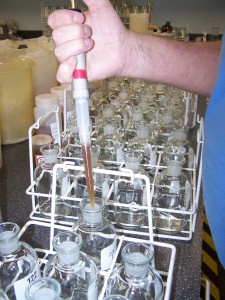 The biochemical oxygen demand (BOD) test is a measurement of the quantity of oxygen required by bacteria to biologically oxidize organic material under aerobic conditions. The BOD test result is expressed in mg/L but can be calculated as lbs/day to express loading to a wastewater treatment plant (WWTP) or to a receiving water body. The organic matter serves as food for the bacteria and the cell receives energy from the oxidation of this organic matter. By measuring the amount of oxygen consumed by the bacteria during the BOD test, the amount of BOD, often referred to as the food for the bacteria, can be calculated for a given sample.
The biochemical oxygen demand (BOD) test is a measurement of the quantity of oxygen required by bacteria to biologically oxidize organic material under aerobic conditions. The BOD test result is expressed in mg/L but can be calculated as lbs/day to express loading to a wastewater treatment plant (WWTP) or to a receiving water body. The organic matter serves as food for the bacteria and the cell receives energy from the oxidation of this organic matter. By measuring the amount of oxygen consumed by the bacteria during the BOD test, the amount of BOD, often referred to as the food for the bacteria, can be calculated for a given sample.
BOD testing can be separated into three measurable categories: total BOD (tBOD), soluble BOD (sBOD), and carbonaceous BOD (cBOD). The tBOD measures all biodegradable material in the sample. The sBOD measures the dissolved biodegradable material in the sample. The cBOD measures the amount of oxygen required by bacteria to biologically oxide the carbonaceous fraction of organics and removes oxygen consumption attributable to nitrification.
To run the BOD test, the water samples of interest are diluted with nutrient rich water containing a phosphate buffer solution, a magnesium sulfate solution, a calcium chloride solution, and a ferric chloride solution, and possibly seeded with a known amount of bacteria. Dilutions are determined by estimating the amount of BOD in the sample using the measured chemical oxygen demand (COD) or another suitable surrogate. The dissolved oxygen (DO) of the sample is measured initially after mixing the solution and again after five days of incubation for the BOD5 test, or after one day for the BOD1 test. The amount of DO removed from the water is relative to the amount of biodegradable material oxidized by the bacteria in the sample (seeded or indigenous). The sample dilution and amount of DO removed are used to calculate the BOD result in mg/L. To be utilized in the calculation of the BOD result, each BOD test bottle must have a residual DO of 1.0 mg/L and have had a DO uptake of at least 2.0 mg/L.
Quality control for this procedure is complex and is sometimes misinterpreted from the Standard Methods procedure. Care should be taken to ensure compliance with the most recent version of Standard Methods is met. BOD is almost always an NPDES permitted test that requires reporting to state or federal environmental compliance departments. Contact EBS if you have any questions about running the BOD test, or would like your laboratory procedure assessed by a BOD testing expert.

